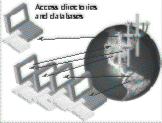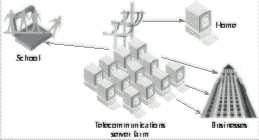Solutions That Affect Access for Families and That Empower Organizations and Small Businesses
You know about accelerating the deployment of applications and solutions that enhance and extend existing technology infrastructures in businesses and different types of organizations. Now let s look at how individuals, households, or organizations that usually have neither the funds nor the personnel to take advantage of any type of computing information resource could also greatly benefit from thin-client/server technology.
Computing is expensive for individuals and families who are trying to either keep up with current technology or make sure that their kids have access to the best and most recent information. Not only is the point of entry (that is, the PC) expensive, but figuring out how to use the PC can also be costly in terms of time and resources. I wonder how many people would watch television if viewers were required to add hardware or other components to their televisions every year with the new fall television lineup. It s about time computing resources were made as simple to access as television.
Individuals and households actually present a huge opportunity for a large telecommunications company, such as AT&T, MCI, or WorldCom, that is willing to invest in server farms that make applications and information available to consumers through thin-client/server devices. Rather than requiring individual house-holds to update computer hardware or precluding their access to information and applications, a telecommunications provider could provide a thin-client/server computing device, such as a Windows-based terminal, with the costs included in a monthly fee for computing services. This arrangement would make home computing access similar to access to cable television programming or to the method used to distribute cellular phones with a cellular account.
Telecommunications companies can make computing accessible using thin-client/ server solutions.
A European telecommunications company, France Telecom, already provides directory and other database services through terminals installed in every telephone subscriber s home. This model could be extended to offer the use of software applications through the thin-client/server technology.
France Telecom created France Teletel in 1980 to provide telephone directory services to its customers. The company distributed a simple terminal with a keyboard to every household with a telephone, in lieu of a telephone directory. Today customers of France Telecom use a device known as the Minitel not only for directory assistance but also for access to about 25,000 different information databases. Currently, 6.5 million Minitel terminals exist, with an additional 600,000 personal computers that use terminal-emulation software to access the directory and database services. Subscriptions and access via the Internet are also offered to places outside of France. (See Figure 9-3.)
FIGURE 9-3
France Telecom uses Minitel devices for directory and other services in every household with a telephone.

To get more information about the Minitel services or access using emulation software through the Web, see the company s Web site at:
http://www.minitel.com
The Minitel terminals are character-based and serve the specific purpose of providing directory services and access to databases. Since France Telecom understands the thin-client/server model for distributing information, it would be a logical step to add an application server farm to its network, for access by the 600,000 customers accessing the services by personal computer. Windows-based terminals could be distributed to households to replace the Minitel text terminals for a wide range of graphical computing offerings from productivity applications, Web-based information, or other more engaging uses of technology. I wouldn t be surprised if France Telecom found the ICA thin-client/server software an effective addition to Minitel terminals in the future.
Imagine the ramifications of a successful pilot project in France that could then be deployed by other telecommunications companies across the globe. Server farms all over the world could host a full complement of productivity, entertainment, research, e-mail, and reference software and services. Students could access their documents from terminals or computers regardless of whether they re working at home or in school, and they wouldn t need to purchase expensive laptop computers. And since thin-client/server software keeps improving, soon users would be able to access multimedia via even the thinnest protocols, such as ICA, which could make the thin-client/server solution useful for all types of curriculum materials and functions within educational institutions, for example. (See Figure 9-4.)
FIGURE 9-4
Households and schools can take advantage of thin-client/server computing.

Schools that want to use laptop computer system programs for student access must figure in the cost of entry for the student (that is, how much the student would have to spend to purchase the appropriate hardware), sufficient bandwidth capabilities, and maintenance. Using a thin-client/server model for this type of pro-gram would help reduce these kinds of costs and would offer equal access even to students and schools with restricted funds.
While working in my previous position as the academic programs manager for Microsoft s Internet Platform and Tools Division, I encountered the following situation: Often, a barrier to using Microsoft programming languages was the pervasive existence of legacy hardware in institutions of higher education. Academic programs used old versions of programming languages that would run on the old hardware that was available to students. The legacy hardware precluded the schools use of the most recent versions of programming languages as tools for supporting the technical disciplines, such as computer science, business information systems, engineering, and so on. Many schools simply do not have the funds for either the requisite hardware or adequate IS support. The Idaho State University case study in Chapter 8 illustrates how valuable the thin-client/server solution can be not only for schools but also for organizations constrained by these issues.
In the same way that thin-client/server server farms could provide students and their families with access to computing, regardless of socioeconomic level, telephone companies could economically provide services to small businesses that are unable to afford their own computing infrastructures.
Thin-client/server computing can be used to consolidate IS functions for groups of small businesses.
As a small business owner myself, I know what it takes to purchase and set up conventional hardware solutions. It s not as easy as it was when I was working at Microsoft and could call the Help desk, install the latest version of software right off the corporate servers, or send e-mail to some of my colleagues and get answers to technical questions. In setting up and running my small business applications, I learned a great deal about the varying quality of product support from hardware and software vendors. As ven-dors software and hardware products get more complex, the vendors try to cut costs by putting information out on the Web. But it s not necessarily easy to find the answers you re looking for on the Internet, and doing so can be quite time-consuming as you try to support your own software needs.
Recently, when I asked my 8-year-old son, Sam, what he thought I did for work, he told me that my job was to support the network and computers in our house. Obviously, since I ve been on my own, I ve spent too many hours trying to fix system problems, install hardware, or get my internal network to run. I ve had to install workarounds, including older or different versions of software, on various computers with different operating systems, just to get my e-mail from a provider (MSN) that didn t support e-mail access by my computer, which is running Microsoft Windows NT as the operating system. As a result of my experiences, I fully intend to off-load some of my internal support work to a thin-client/server solution that will be provided by a local Internet Service Provider (ISP) using WinFrame.
EAN: 2147483647
Pages: 158